Packet Loss Characterization Using Cross Layer Information and HMM for Wi-Fi Networks
Abstract
:1. Introduction
2. Related Works
3. Packet Loss Modeling with Cross Layer Information
3.1. Measurement Setup and Data Collection
3.2. Variables of Interest
4. Proposed Model
4.1. Order Selection
4.2. Performance Evaluation
4.3. Competing Models Comparison
5. Conclusions
Author Contributions
Funding
Data Availability Statement
Acknowledgments
Conflicts of Interest
References
- Cisco. Cisco Annual Internet Report (2018–2023). 2020. Available online: https://www.cisco.com/ (accessed on 20 August 2022).
- Atzeni, D.; Bacciu, D.; Mazzei, D.; Prencipe, G. A Systematic Review of Wi-Fi and Machine Learning Integration with Topic Modeling Techniques. Sensors 2022, 13, 4925. [Google Scholar] [CrossRef] [PubMed]
- Kassa, L.; Deng, J.; Davis, M.; Cai, J. Performance of WLAN in Downlink MU-MIMO Channel with the Least Cost in Terms of Increased Delay. Electronics 2022, 11, 2851. [Google Scholar] [CrossRef]
- Silva, C.A.G.d.; Pedroso, C.M. MAC-Layer Packet Loss Models for Wi-Fi Networks: A Survey. IEEE Access 2019, 7, 512–531. [Google Scholar]
- Gilbert, E.N. Capacity of a burst-noise channel. Bell Syst. Technol. J. 1960, 5, 1253–1265. [Google Scholar]
- Elliott, E.O. Estimates of error rates for codes on burst-noise channels. Bell Syst. Technol. J. 1963, 5, 1977–1997. [Google Scholar] [CrossRef]
- Nobre, M.; Silva, I.; Guedes, L.A. Performance evaluation of wirelesshart networks using a new network simulator 3 module. Comput. Elec. Eng. 2015, 41, 325–341. [Google Scholar]
- Russ, S.H.; Haghani, S. 802.11g Packet-loss Behavior at High Sustained Bit Rates in the Home. IEEE Trans. Cons. Electon. 2009, 2, 788–791. [Google Scholar] [CrossRef]
- Kopke, A.; Willig, A.; Karl, H. Chaotic maps as parsimonious bit error models of wireless channels. In Proceedings of the Annual Joint Conference of the IEEE Computer and Communications Society, San Francisco, CA, USA, 30 March–3 April 2003; pp. 513–523. [Google Scholar]
- Carvalho, L.; Angeja, J.; Navarro, A. A new packet loss model of the ieee 802.11g wireless network for multimedia communications. IEEE Trans. Cons. Elect. 2005, 3, 809–814. [Google Scholar] [CrossRef]
- Cardoso, K.V.; Rezende, J.F.D. Accurate hidden markov modeling of packet losses in indoor 802.11 networks. IEEE Commun. Lett. 2009, 6, 417–419. [Google Scholar] [CrossRef]
- Hasan, S.F.; Siddique, N.H.; Chakraborty, S.; De, S. HMM-based modelling of roadside- to-vehicle WLAN communications. In Proceedings of the 7th International Symposium on Communication Systems, Networks Digital Signal Processing (CSNDSP 2010), Newcastle, UK, 21–23 July 2010; pp. 427–431. [Google Scholar]
- Allahdadi, A.; Morla, R. Anomaly detection and modeling in 802.11 wireless networks. J. Netw. Syst. Manag. 2019, 1, 3–38. [Google Scholar] [CrossRef] [Green Version]
- Koda, Y.; Yamamoto, K.; Nishio, T.; Morikura, M. Time series measurement of IEEE 802.11ad signal power involving human blockage with HMM-based state estimation. In Proceedings of the IEEE 86th Vehicular Technology Conference (VTC-Fall), Toronto, ON, Canada, 24–27 September 2017; pp. 1–5. [Google Scholar]
- Senthilkumar, S. Hidden markov model based channel selection framework for cognitive radio network. Comput. Electr. Eng. 2018, 65, 516–526. [Google Scholar]
- Rabiner, L.; Juang, B. An Introduction To Hidden Markov Models. IEEE ASSP Magaz. 1986, 1, 4–16. [Google Scholar]
- Adams, S.; Beling, P.A.; Cogill, R. Feature Selection for Hidden Markov Models and Hidden Semi-Markov Models. IEEE Access 2016, 4, 1642–1657. [Google Scholar] [CrossRef]
- Silveira, F.; e Silva, E.D.S. Predicting Packet Loss Statistics with Hidden Markov Models for FEC Control. Comput. Netw. 2012, 2, 628–641. [Google Scholar] [CrossRef]
- Salih, O.S.; Wang, C.X.; Laurenson, D.I.; He, Y. Hidden Markov Models for Packet-level Errors in Bursty Digital Wireless Channels. In Proceedings of the Loughborough Antennas & Propagation Conference, Loughborough, UK, 16–17 November 2009; pp. 385–388. [Google Scholar]
- Wang, C.X.; Xu, W. Packet-level Error Models for Digital Wireless Channels. In Proceedings of the IEEE International Conference on Communication, Seoul, Korea, 16–20 May 2005; pp. 2184–2189. [Google Scholar]
- Wang, C.X.; Xu, W. A New Class of Generative Models for Burst-Error Characterization in Digital Wireless Channels. IEEE Trans. Commun. 2007, 3, 453–462. [Google Scholar]
- Upadhyay, R.; Tokekar, S.; Vyavahare, P.D. Performance analysis of wlan physical layers using markov channel model. Comput. Elect. Eng. 2012, 3, 616–625. [Google Scholar]
- Hartwell, J.A.; Fapojuwo, A.O. Modeling and characterization of frame loss process in IEEE 802.11 wireless local area networks. In Proceedings of the IEEE 60th Vehicular Technology Conference, Los Angeles, CA, USA, 26–29 September 2004; pp. 4481–4485. [Google Scholar]
- Arauz, J.; Krishnamurthy, P. Markov Modeling of 802.11 Channels. In Proceedings of the IEEE 58th Vehicular Technology Conference (VTC), Orlando, FL, USA, 6–9 October 2003; pp. 771–775. [Google Scholar]
- Yu, Y.; Miller, S.L. A Four-State Markov Frame Error Model for the Wireless Physical Layer. In Proceedings of the IEEE Wireless Communications and Networking Conference, Washington, DC, USA, 1–15 March 2007; pp. 2053–2057. [Google Scholar]
- Feng, J.; Liu, Z.; Ji, Y. Wireless channel loss analysis—A case study using WIFI-direct. In Proceedings of the International Wireless Communications and Mobile Computing Conference (IWCMC), Nicosia, Cyprus, 4–8 August 2014; pp. 244–249. [Google Scholar]
- Sanneck, H.A.; Carle, G. Framework model for packet loss metrics based on loss run-lengths. Multim. Comput. Netw. 1999, 3969, 177–187. [Google Scholar]
- Zhou, K.; Jia, X.; Xie, L.; Chang, Y.; Tang, X. Channel assignment for WLAN by considering overlapping channels in SINR interference model. In Proceedings of the International Conference on Computing, Networking and Communications (ICNC), Maui, HI, USA, 30 January–2 February 2012; pp. 1005–1009. [Google Scholar]
- Heinze, G.; Wallisch, C.; Dunkler, D. Variable selection—A review and recommendations for the practicing statistician. Biomethod. J. 2020, 3, 431–449. [Google Scholar]
- Rivera-Lara, E.J.; Herreriás-Hernández, R.; Pérez-Diáz, J.A.; Garcá-Hernández, C.F. Analysis of the Relationship between QoS and SNR for an 802.11g WLAN. In Proceedings of the International Confererence on Communication Theory, Reliability, and Quality of Service, Bucharest, Romania, 29 June–5 July 2008; pp. 103–107. [Google Scholar]
- Liu, R.P.; Sutton, G.J.; Yang, X.; Collings, I.B. Modelling QoS Performance of IEEE 802.11 DCF under Practical Channel Fading Conditions. IEEE Intern. Confer. Commun. 2011, 1, 1–6. [Google Scholar]
- Karmakar, R.; Chattopadhyay, S.; Chakraborty, S. Dynamic Link Adaptation in IEEE 802.11ac: A Distributed Learning Based Approach. In Proceedings of the IEEE 41st Conference on Local Computer Networks Workshops, Dubai, United Arab Emirates, 7–10 November 2016; pp. 87–94. [Google Scholar]
- Mukherjee, S.; Peng, X.; Gao, Q. QoS Performances of IEEE 802.11 EDCA and DCF: A Testbed Approach. In Proceedings of the 5th International Conference on Wireless Communications, Networking and Mobile Computing, Beijing, China, 24–26 September 2009; pp. 1–5. [Google Scholar]
- Babalola, O.P.; Balyan, V. Vertical Handover Prediction Based on Hidden Markov Model in Heterogeneous VLC-WiFi System. Sensors 2022, 22, 2473. [Google Scholar]
- Pohle, J.; Langrock, R.; van Beest, F.M.; Schmidt, N.M. Selecting the number of states in hidden markov models: Pragmatic solutions illustrated using animal movement. J. Agric. Biol. Environ. Stat. 2017, 22, 270–293. [Google Scholar] [CrossRef]
- Berkhin, P. A survey of clustering data mining techniques. Group Multidiscip. Data 2006, 1, 25–71. [Google Scholar]
- Takyi, K.; Bagga, A. Real-time application clustering in wide area networks. Comput. Electron. Eng. 2020, 85, 1–15. [Google Scholar] [CrossRef]
- Li, Y.; Cai, J.; Yang, H.; Zhang, J.; Zhao, X. A Novel Algorithm for Initial Cluster Center Selection. IEEE Access 2019, 74, 74683–74693. [Google Scholar]
- Urmela, S.; Nandhini, M. Collective Dendrogram Clustering with Collaborative Filtering for Distributed Data Mining on Electronic Health Records. In Proceedings of the 2nd International Conference on Electronics, Communication and Computing Technologies (ICECCT), Beijing, China, 22–24 February 2017; pp. 1–5. [Google Scholar]
- Crovella, M.E.; Bestavros, A. Self-similarity in World Wide Web traffic: Evidence and possible causes. IEEE/ACM Trans. Netw. 1997, 6, 835–846. [Google Scholar] [CrossRef] [Green Version]
- Tang, M.F.; Abbou, F.M.; Abid, A.; Mishra, V.N.; Chuah, H.T. Packet loss rate of an optical burst switch with nonlinear optical loop mirrors. IEICE Elect. Express 2006, 11, 243–248. [Google Scholar] [CrossRef] [Green Version]
- Morsy, M.H.S.; Sowailem, M.Y.S.; Shalaby, H.M.H. Upper and lower bounds of burst loss probability for a core node in an Optical Burst Switched network with Pareto distributed arrivals. In Proceedings of the IEEE 17th International Conference on Telecommunications, Doha, Qatar, 4–7 April 2010; pp. 523–527. [Google Scholar]
- Lou, H.L. Implementing the Viterbi Algorithm. IEEE Signal Proc. Magaz. 1995, 5, 42–52. [Google Scholar] [CrossRef]
- R Core Team: R: A Language and Environment for Statistical Computing. R Foundation for Statistical Computing. 2021. Available online: https://www.R-project.org/ (accessed on 10 December 2021).
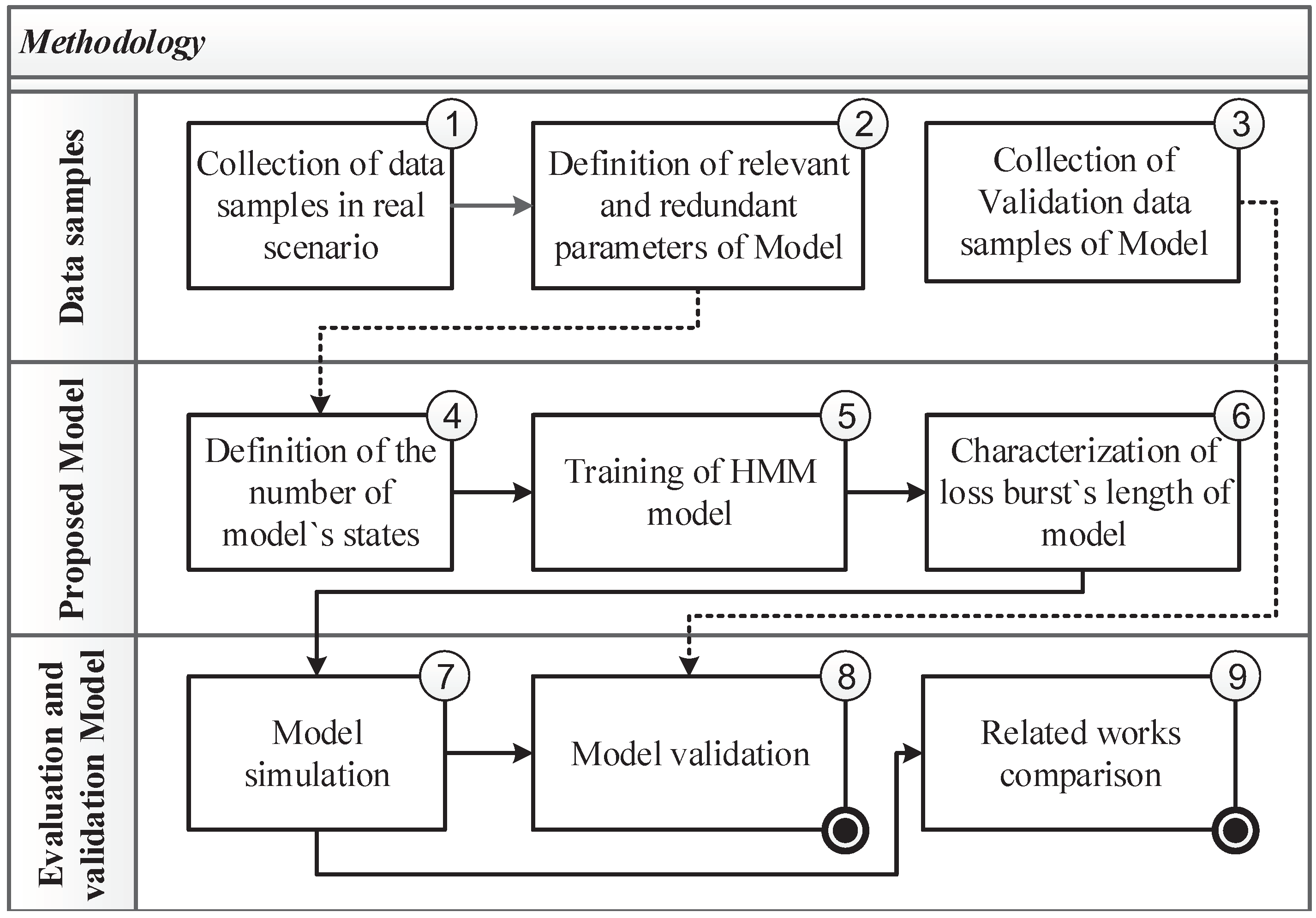

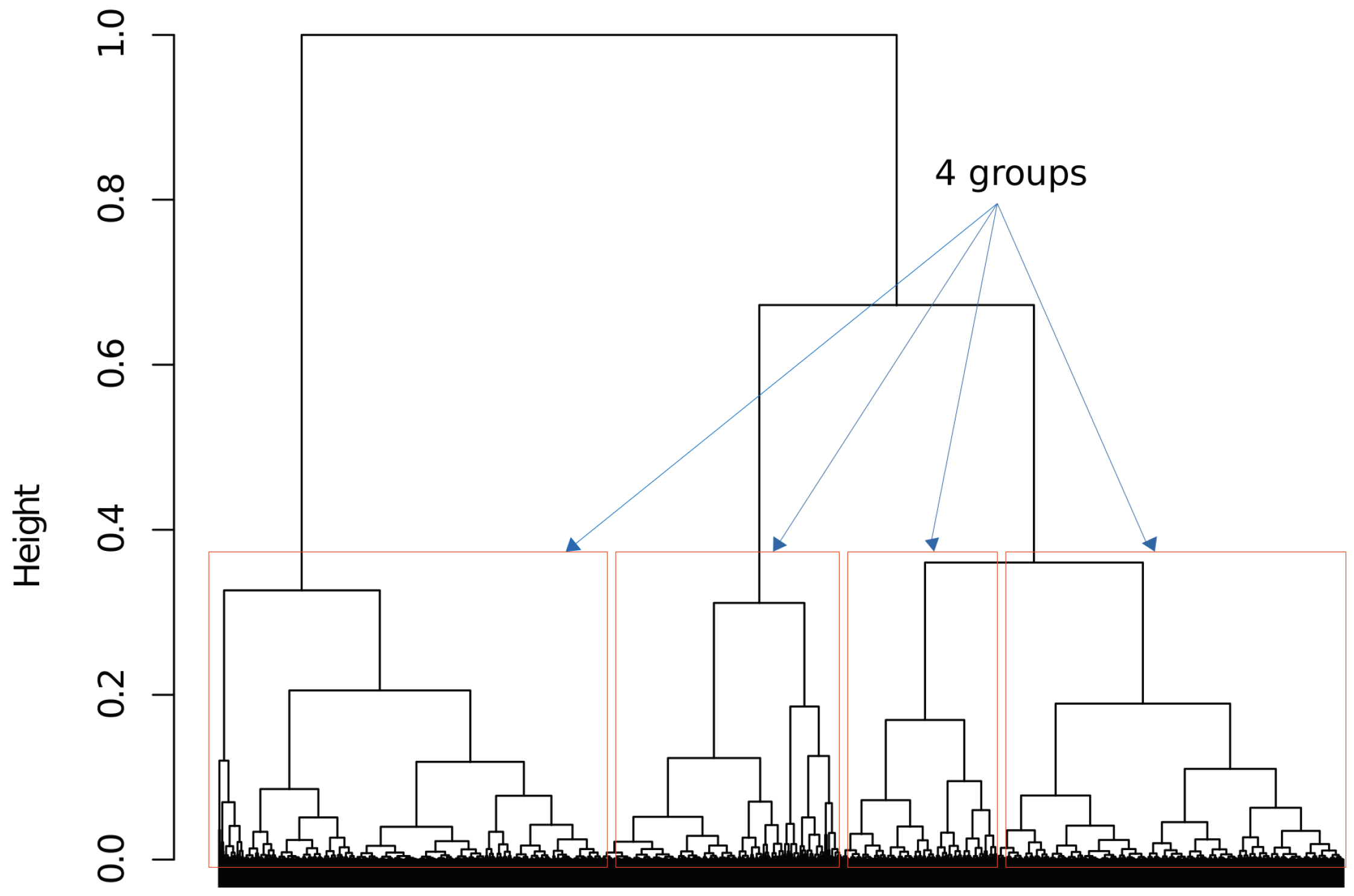


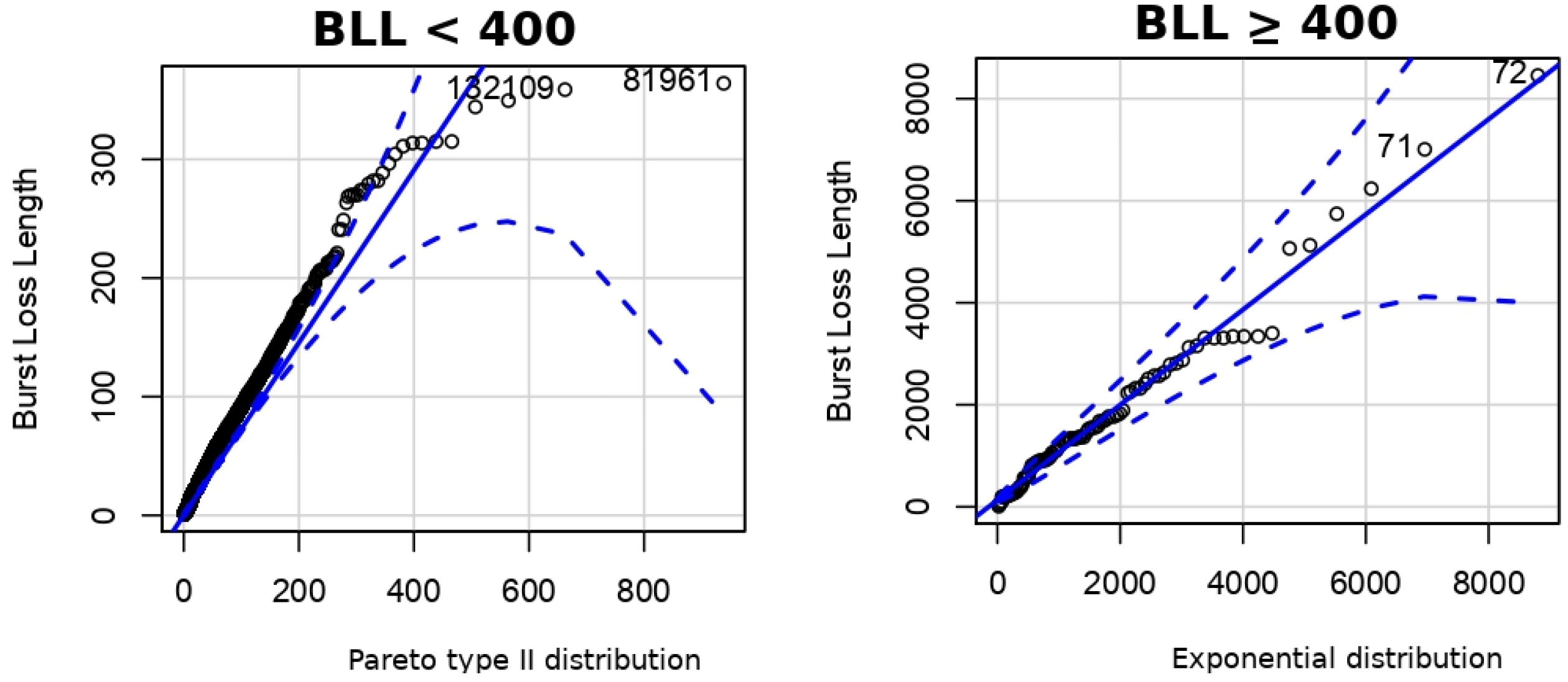

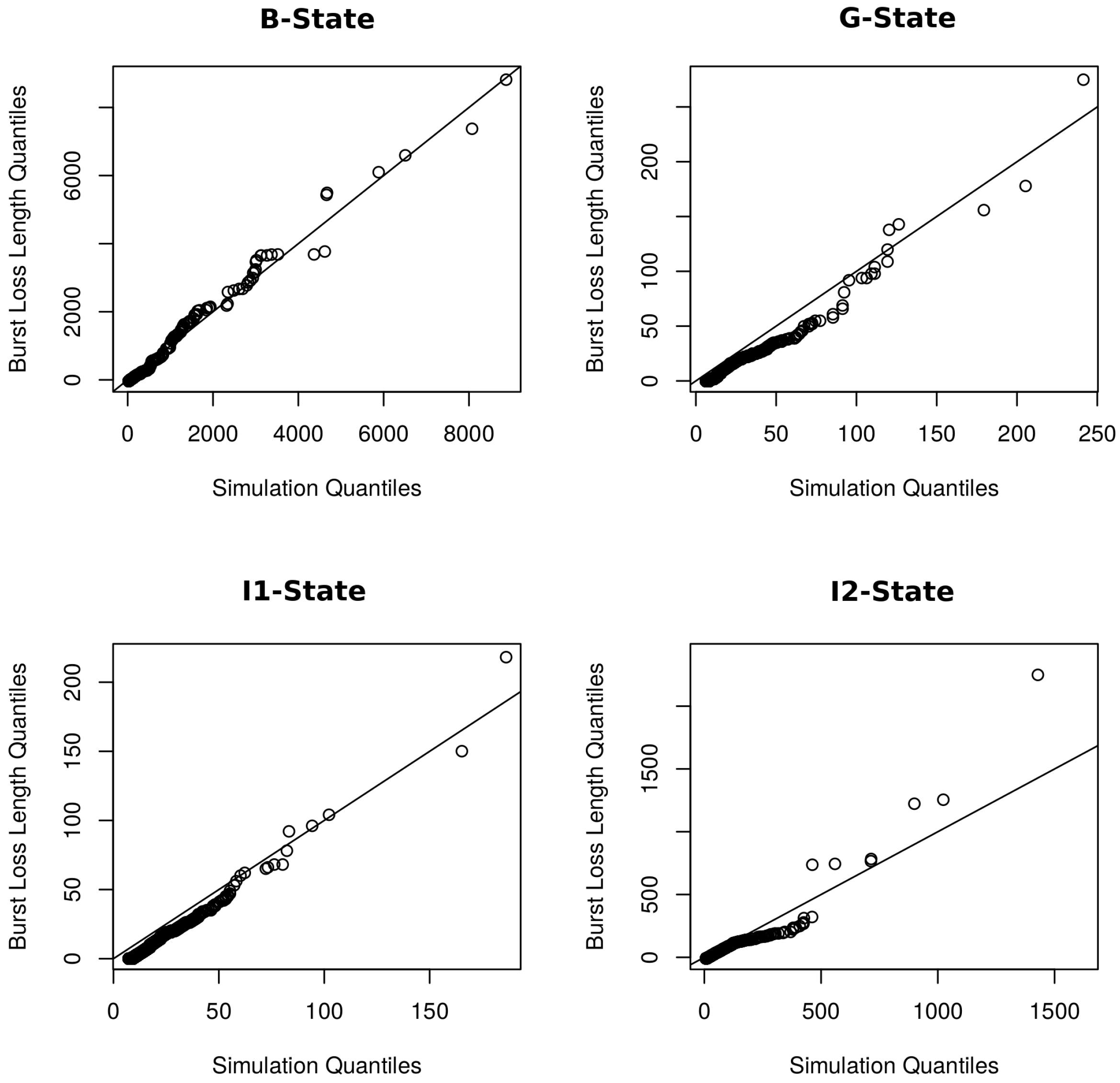
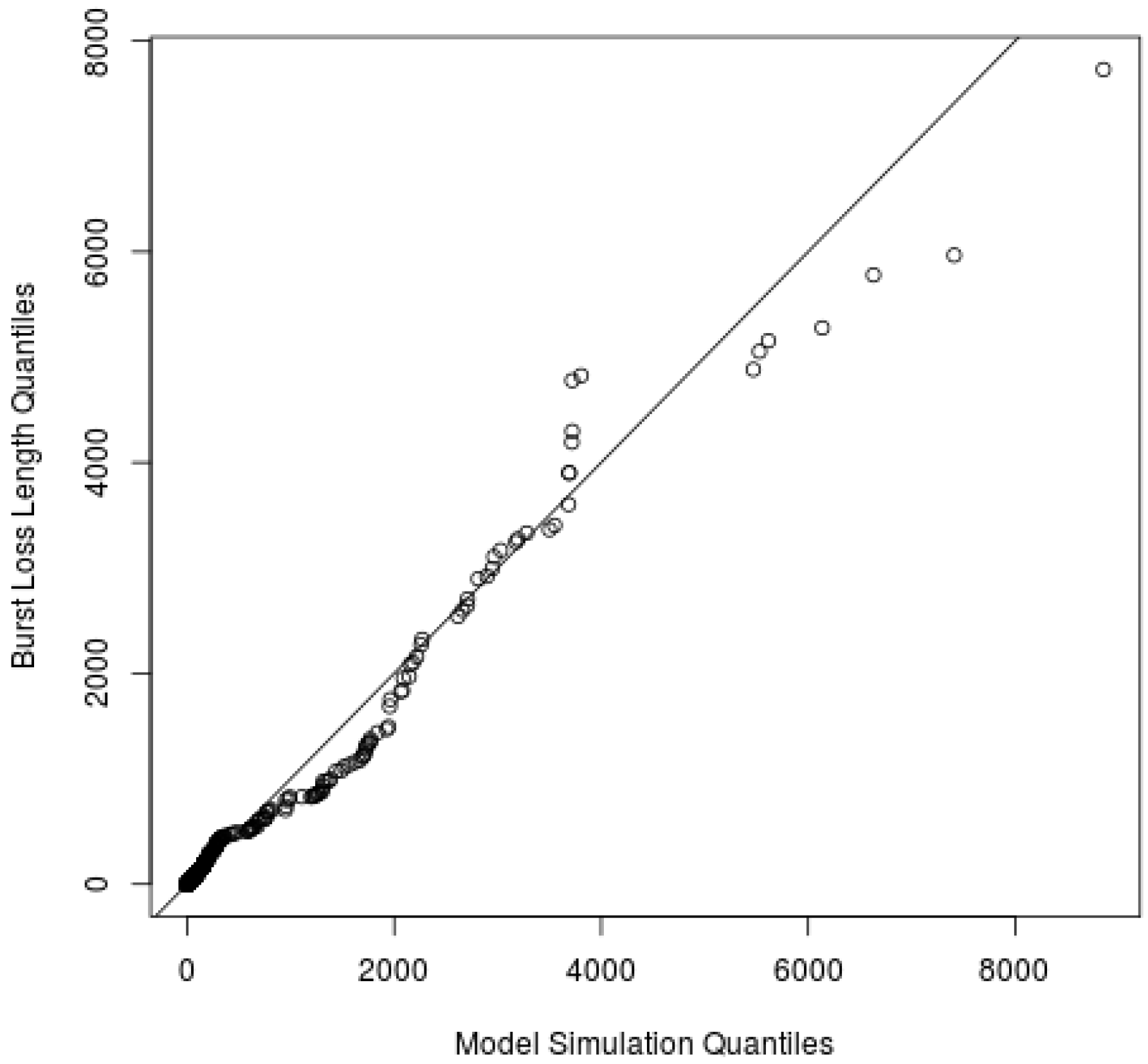
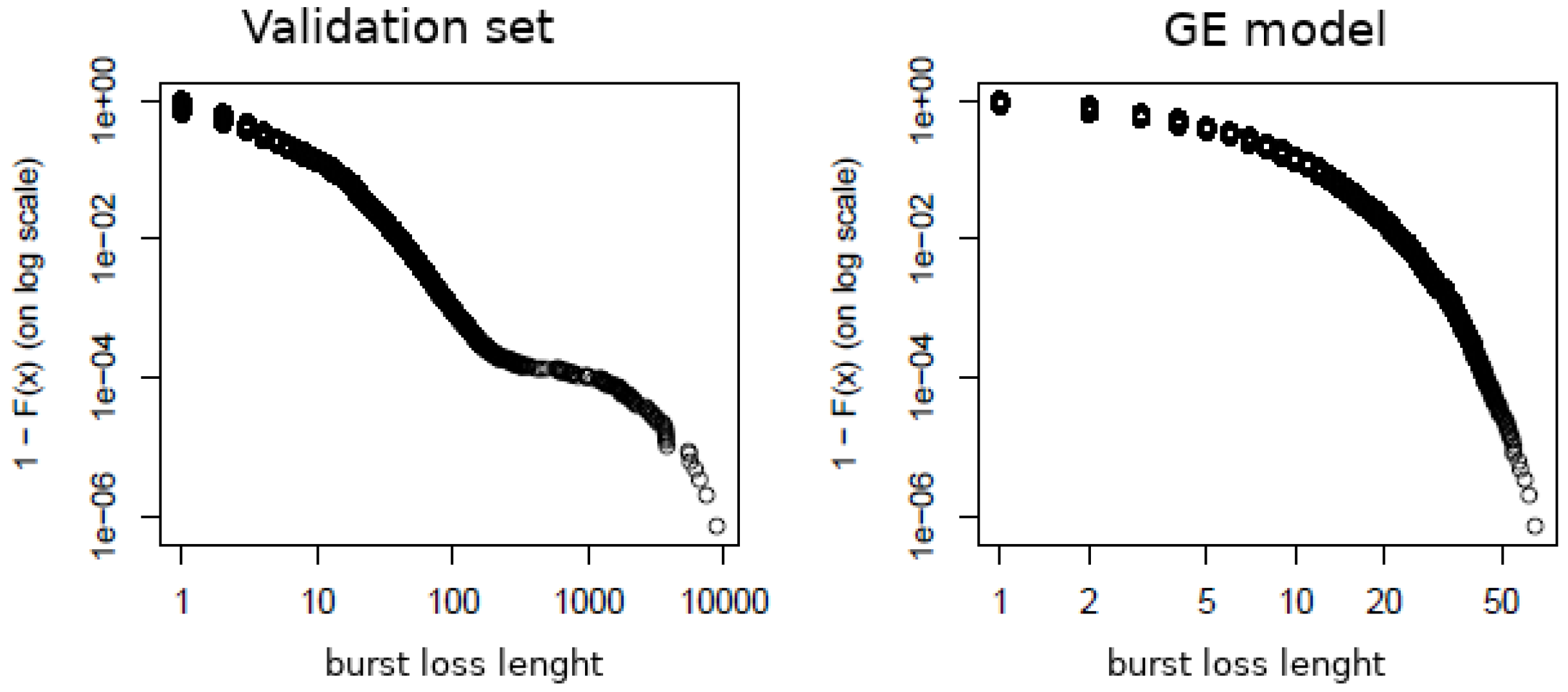
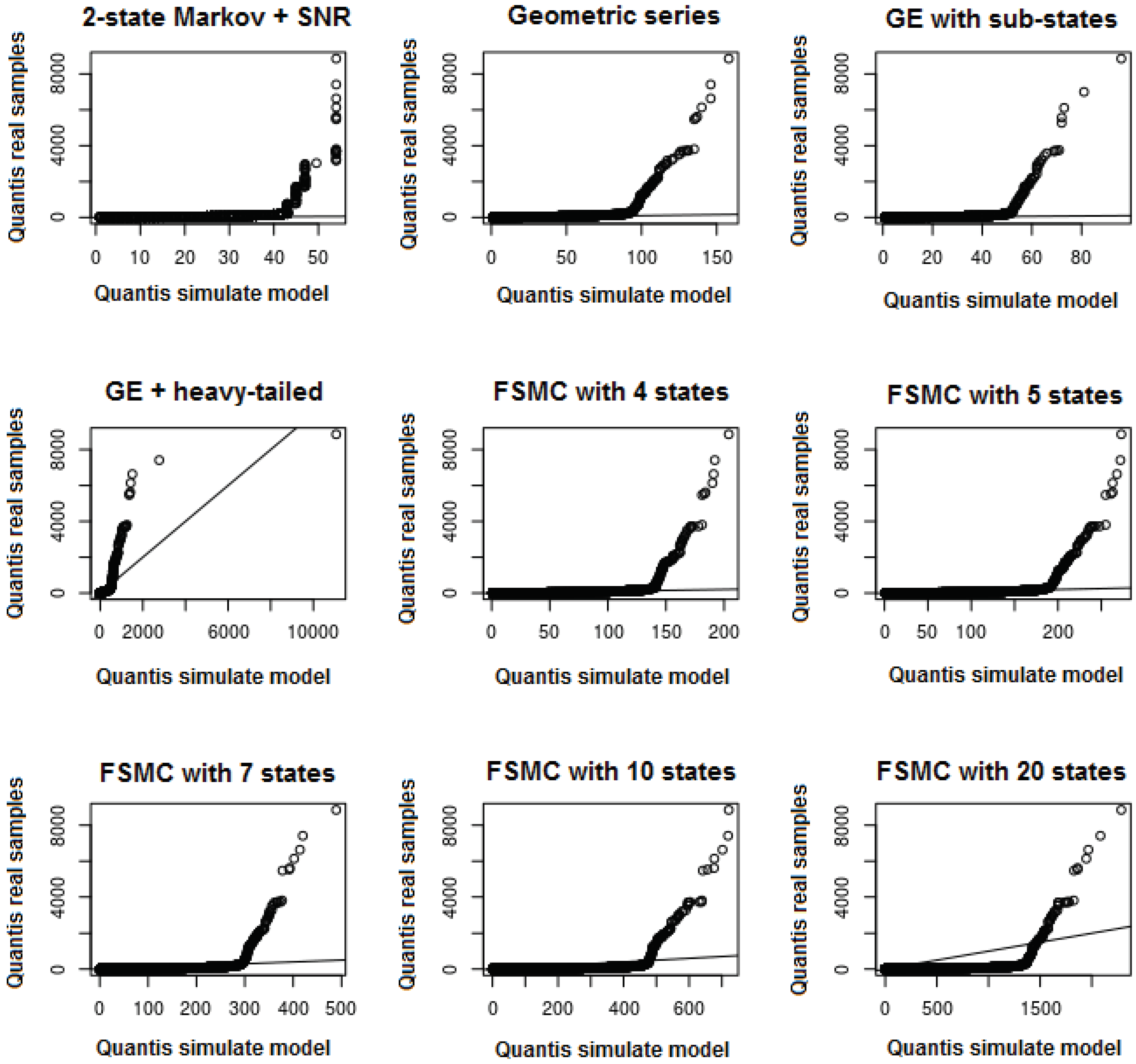
| Characteristics | [24] | [10] | [11] | [19] | [25] | [26] | [23] | [27] | [8] | Proposed Model |
|---|---|---|---|---|---|---|---|---|---|---|
| IEEE 802.11 | ✔ | ✔ | ✔ | - | ✔ | ✔ | ✔ | - | ✔ | ✔ |
| SNR | ✔ | - | - | - | ✔ | - | - | - | - | ✔ |
| Channel Occupation (%) | - | - | - | - | - | - | - | - | - | ✔ |
| HMM | - | - | ✔ | ✔ | - | - | ✔ | - | - | ✔ |
| Heavy-tail distribution | - | - | - | - | ✔ | - | - | - | ✔ | ✔ |
| AP Information | Description |
|---|---|
| AP characteristics | 300 Mbps Wireless N ADSL2+ Modem Router |
| Internet Service Provider | Bridge mode |
| Channel number | Fixed for each collection (1, 6, or 11) |
| Transmitter power | Maximum |
| Wi-Fi standard | IEEE 802.11 b + g + n (auto) |
| Channel Bandwidth | 11b/g – 20 MHz or 11n – 20/40 MHz (auto) |
| State | PLR | Standard Deviation | Classification |
|---|---|---|---|
| 1 | 60.97% | 24.93% | B |
| 2 | 0.55% | 4.09% | G |
| 3 | 2.02% | 8.36% | I1 |
| 4 | 12.78% | 21.76% | I2 |
| State | Distribution | Estimated Parameters |
|---|---|---|
| B | Pareto type II +Exponencial | e |
| G | Pareto type II +Exponencial | e |
| I1 | Pareto type II | e |
| I2 | Pareto type II | e |
| State | Validation Data Set | Model Simulation | ||
|---|---|---|---|---|
| Average | Std. Dev. | Average | Std. Dev. | |
| B | 5.67 | 34.44 | 5.80 | 28.64 |
| G | 3.00 | 5.75 | 2.99 | 6.01 |
| I1 | 3.03 | 4.70 | 2.97 | 4.48 |
| I2 | 4.66 | 11.04 | 4.56 | 11.89 |
| Model | Average BLL | Maximum BLL | Std. Dev. BLL | MSE |
|---|---|---|---|---|
| Validation data set | 5.37 | 8853 | 31.68 | 0 |
| GE | 5.36 | 65 | 4.832 | 0.352 |
| [24] | 4.88 | 54 | 4.52 | 0.319 |
| [10] | 5.37 | 158 | 7.53 | 0.352 |
| [26] | 6.52 | 96 | 6.01 | 0.352 |
| [8] | 8.11 | 11,074 | 24.08 | 2.907 |
| [27] 4 states | 16.76 | 204 | 15.78 | 0.352 |
| [27] 5 states | 22.52 | 273 | 21.45 | 0.352 |
| [27] 7 states | 34.85 | 489 | 33.80 | 0.351 |
| [27] 10 states | 54.19 | 721 | 53.39 | 0.349 |
| [27] 20 states | 150.5 | 2286 | 156.67 | 0.318 |
| Proposed model | 5.52 | 7728 | 29.75 |
Publisher’s Note: MDPI stays neutral with regard to jurisdictional claims in published maps and institutional affiliations. |
© 2022 by the authors. Licensee MDPI, Basel, Switzerland. This article is an open access article distributed under the terms and conditions of the Creative Commons Attribution (CC BY) license (https://creativecommons.org/licenses/by/4.0/).
Share and Cite
da Silva, C.A.G.; Pedroso, C.M. Packet Loss Characterization Using Cross Layer Information and HMM for Wi-Fi Networks. Sensors 2022, 22, 8592. https://doi.org/10.3390/s22228592
da Silva CAG, Pedroso CM. Packet Loss Characterization Using Cross Layer Information and HMM for Wi-Fi Networks. Sensors. 2022; 22(22):8592. https://doi.org/10.3390/s22228592
Chicago/Turabian Styleda Silva, Carlos Alexandre Gouvea, and Carlos Marcelo Pedroso. 2022. "Packet Loss Characterization Using Cross Layer Information and HMM for Wi-Fi Networks" Sensors 22, no. 22: 8592. https://doi.org/10.3390/s22228592






